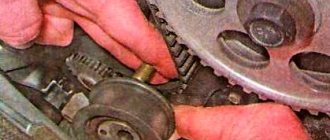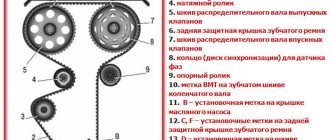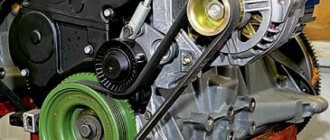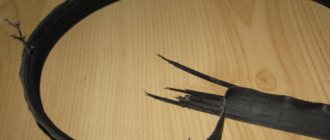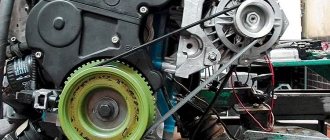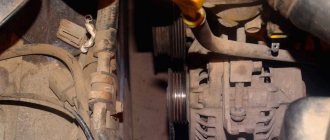A broken timing belt leads to damage to valves, and in some cases, pistons and other important engine parts. To perform a timing belt replacement, certain qualifications are required; in most cases, timing belt replacement is performed at a car service center. Replacing the timing belt yourself is only possible if the car owner has good skills and strictly follows the sequence of operations according to the car manufacturer’s instructions.
Why do you need a timing belt?
The engine's gas distribution mechanism (GRM) is responsible for the correct flow of the fuel mixture into the engine and the release of exhaust gases from the engine through the exhaust system. Rotating camshafts, through eccentrics located on them, through pushers, rocker arms and rods, open or close valves, ensuring proper engine operation.
The timing belt connects the crankshaft to one or two camshafts. The timing belt synchronizes the operation of the pistons and valves by turning the camshaft at exactly half the speed of the crankshaft. Thanks to synchronization, an exact coincidence of engine operating strokes is ensured: the valves open and close exactly at one or another piston position.
On some car models, the timing belt may also drive the water pump and oil pump.
When to change the timing belt
The timing belt is replaced within the time frame specified by the vehicle manufacturer in the technical operating manual. Different car manufacturers indicate different timing belt replacement intervals; most often, replacement periods are indicated from 60,000 km to 200,000 km. The timing belt is most often replaced during scheduled maintenance.
It is recommended to regularly visually check the condition of the timing belt, although due to the fact that the belt is hidden by a casing, this is not so easy to do.
If during a visual inspection at least one of these signs is revealed, the timing belt should be urgently replaced:
- Cracks on either side of the belt.
- The side edges of the belt are frayed.
- Belt teeth are peeling, worn or cut.
- The belt shows scuffs or burn marks.
- There are traces of black rubber dust on the protective casing or parts in contact with the belt.
The need to replace the timing belt may be indirectly indicated by the following signs in the vehicle's behavior:
- Failures of the ignition system, the engine starts the second or third time, or stalls, all these problems can arise due to a belt tooth jumping on the pulley, the fuel ignites earlier or later than necessary.
- Black smoke from the exhaust pipe may occur due to a loose timing belt, as a result of which the fuel does not burn completely, burning out in the exhaust system, which leads to an increase in temperature, melting and destruction of the catalyst.
- Uncharacteristic sounds, ticking and clicking sounds when the engine is running, and the sounds intensify with increasing engine speed, such sounds can occur when the timing belt is severely worn, but the same sounds can also occur due to the destruction of the water pump or generator bearing.
- Antifreeze leaks or traces of oil in the area of the timing belt guard, antifreeze may leak from the water pump, oil from the crankshaft seal, oil or antifreeze getting on the belt will lead to the need to replace the belt, rollers and pulleys.
- If the starter spins but the engine does not start, the timing belt may have broken.
Many experienced auto mechanics advise changing the timing belt more often than indicated in the manufacturers' recommendations: every 3 years with an average vehicle mileage of 15,000 kilometers per year, that is, every 40-45 thousand kilometers. They argue their position by the fact that a sudden break in the timing belt will lead to the need for a major overhaul of the engine, which costs much more than replacing the timing belt.
Experienced auto mechanics also advise changing the belt if the car's mileage is very low and the belt is already 7-8 years old. Over time, the elasticity of the rubber decreases, the belt becomes covered with cracks, which sooner or later will lead to its breakage and expensive engine repairs. When replacing a timing belt, the water pump (pump) is often changed at the same time. It's just convenient to do it at the same time.
Mobile operator
SIM card from Yota with unlimited Internet for tablets
The first launch of the first 4G network in Russia, authorized by the Ministry of Communications of Russia, took place by the owners of the Yota brand at the beginning of 2012 in the city of Novosibirsk.
As of March 2015, 4G networks have been launched into commercial operation in 39 regions of Russia. 4G is expected to launch in other cities. As of the end of 2014, Yota’s subscriber base was 1.2 million users.
Providers
Shareholders of MegaFon OJSC and Scartel LLC (Yota brand) announced a merger of assets, their press service reported. As a result of the agreements reached by the shareholders, the holding company Garsdale was created, combining 100% of the shares of Scartel and more than 50% of the shares of OAO MegaFon.
Launch history
In 2006, co-owner of St. Petersburg Denis Sverdlov and entrepreneur Sergei Adonyev decided to create the first operator in Russia operating on the basis of the then new data transmission technology - WiMAX. The name of the company was invented during an SMS correspondence: “What if Yota?” In the fall of 2008, Scartel was the first in Russia to deploy WiMAX networks in Moscow and St. Petersburg in the range of 2.5-2.7 GHz.
In 2010, Yota announced plans to switch from WiMAX technology to a new data transmission technology - LTE, and on August 30, 2010, a test launch of the first network of the new communication standard in Russia took place. Yota was the contractor for the construction of the WiMAX network and the subsequent transition to LTE. As of August 2015, Yota users are provided with Internet using LTE technology in 48 regions of Russia.
From April 2014 to April 2015, the general director of Scartel LLC was Anatoly Smorgonsky. His place was taken by Mikhail Dubin, executive director for business development in the mass market. In August 2015, Dubin left both positions, and Konstantin Likhodedov was appointed new general director of Scartel (and executive director of MegaFon).
In November 2016, Vladimir Dobrynin was appointed to the position of General Director of Scartel LLC.
Detailed chronology
- 2007, May - founding of the company.
- 2008, September 2 - official launch of test operation of WiMAX networks at a frequency of 2.5-2.7 GHz in Moscow, St. Petersburg and Ufa under the Yota brand.
- 2008, October 2 - the start of sales of the world's first phone with WiMAX support, HTC MAX 4G, made by HTC by order of Yota specifically for Russia.
- 2008, December 25 - start of sales of WiMAX Express cards for connecting to Yota.
- 2009, March 23 - sales of the first WiMAX laptop in Russia began.
- 2009, June 1 - start of commercial operation for individuals.
- 2009, August 18 - Yota's subscriber base exceeded 100,000 people.
- 2009, October 7 - start of sales of Yota Egg devices.
- 2009, October 12 - subscriber base - more than 150,000 people.
- 2009, December 3 - subscriber base - more than 250,000 people.
- 2009, December 16 - Yota begins testing the network abroad in Russia, in Managua (Nicaragua).
- 2010, August 30 - launch of Russia's first LTE network in Kazan.
- 2010, December 5 - The First International Yota Space Festival started.
- 2011, December 1 - official launch of the Yota network in Belarus.
- 2011, March 3 - Yota, in the presence of Russian Prime Minister Vladimir Putin, signed an agreement with telecom operators VimpelCom, Megafon, MTS and Rostelecom on the development of the LTE network in Russia.
- 2011, June 6 - Yota One and Yota Many went on sale.
- 2012, June 11 - Yota ceases providing services in Belarus.
- 2012, July - reorganization was completed in the form of the merger of Scartel LLC (Yota brand) with MegaFon PJSC.
- 2012, October 9 — Yota was the first in Russia to launch LTE-Advanced mobile communication technology on a commercial network in Moscow. 11 base stations are participating in the launch [ source not specified 425 days
]. - 2014 April 23 - the commercial launch of a new federal cellular operator in Russia - the Yota operator - was announced.
- 2014, August 13 - start of issuing pre-ordered SIM cards of the virtual cellular operator "Yota".
- 2017, January 25 - tariffs with unlimited Internet for smartphones are closed for connection. Introduction of a new tariff line for smartphones with limited traffic.
Cooperation between MegaFon PJSC and Scartel LLC
In April 2014, the emergence of a new federal cellular operator Yota was announced based on the combined network of MegaFon and Scartel. In fact, we are talking about the emergence of another “niche” virtual operator. In August 2014, the issuance of Yota SIM cards to users who pre-ordered started in six cities: Moscow, St. Petersburg, Vladivostok, Khabarovsk, Vladimir and Tula. By the end of 2014, the coverage area had grown to 28 cities, and as of August 2015, the cellular operator Yota issues SIM cards in 52 regions of Russia. The combined network of Megafon and Scartel includes broadcasting only on the 2600 MHz band (Band 7), so in cities where their own LTE networks were built at 800 MHz (Band 20), for example, in Tolyatti or Syzran, Yota It is not possible to provide 4G communication services due to lack of coverage.
As a cellular operator, Yota provides its customers with federal coverage in 2G / 3G / 4G networks, free calls within the Yota network, federal mobile numbers in +7 and 8 formats, as well as a single cost for services within the Russian Federation and coverage areas bordering Russia territories. It is possible to switch to a Yota SIM card while maintaining the old phone number.
In addition, Yota has released a multi-format SIM card that includes NFC and electronic digital signature modules.
In October 2014, the product line of the mobile operator Yota expanded with SIM cards for tablets, allowing customers to independently choose the required speed of unlimited network access, which determines the size of the subscription fee.
Since July 2015, Yota began providing mobile communication services in the Arkhangelsk, Samara, Nizhny Novgorod, Pskov, Novgorod, Tyumen regions, Kalmykia, Mordovia, Udmurtia, and Altai Territory. In August 2015, Yota appeared in the Sverdlovsk, Chelyabinsk, Kaliningrad, Volgograd regions, Perm Territory, Khanty-Mansi Autonomous Okrug, Altai Republic, Dagestan, Chechnya. In September 2015, the issuance of SIM cards started in the Saratov, Belgorod, Kirov, Murmansk, Ivanovo, Tver, Smolensk regions and Stavropol Territory. In October 2015, Yota began providing communication services in the Amur region, Buryatia, Jewish Autonomous Region, Trans-Baikal Territory, Yakutia, and in November 2015 - in the Rostov and Ryazan regions. Since January 2016, you can connect to the Yota mobile operator in the Republic of Ingushetia, Adygea, Kabardino-Balkaria, North Ossetia and the Voronezh region, from February 2016 - in Karachay-Cherkessia, from July 2016 - in the Sakhalin region, from August 2016 - in Komi and Yamal-Nenets Autonomous Okrug, since October 2016 - in the Kurgan region.
On January 25, 2022, tariffs with unlimited Internet are closed for connection. A new tariff line with limited traffic was introduced; the new tariffs have no restrictions on Internet distribution. The company offers the “Unlimited mobile applications” option, where traffic is not spent on some social networks and instant messengers. Subscribers who connected before January 25, 2022 will remain on tariffs with unlimited Internet. [ significance of the fact?
]
Yota and Yota Devices
The division of the companies did not take place in an atmosphere of secrecy, but was not widely covered in the media. This was the first and main reason that many - both users and representatives of the telecom market - still consider Yota and Yota Devices to be one company. [ source not specified 388 days
]
Initially, Yota and Yota Devices were indeed one company. More precisely, the latter were a department within Yota and were engaged in the development of user devices - modems and routers. In 2011, Yota Devices left Big Brother, became a separate company and began developing its own smartphone.
Logo
The company's logo shows an upside-down man, made in a minimalist style, called “Nuf”, or “Nuf”: if you read this word backwards - “Fun” (from English - “fun”).
Consequences of a broken belt
Timing belt failure can be gradual or sudden.
With gradual failure, when the belt stretches, teeth are cut or broken, the valve timing shifts, which leads to difficult engine starting, increased exhaust smoke, increased vibration and the appearance of extraneous noise during engine operation.
If the timing belt suddenly fails, if it breaks, the valves freeze in the position at the moment of the break, the crankshaft continues to rotate by inertia, moving the pistons upward. At a certain point in time, contact between pistons and valves occurs, which leads, at best, to damage to the valves, in some cases to damage to both valves and pistons, in the worst case, in very rare cases, to damage to the cylinder head, crankshaft and even cylinder block. The engine then requires an expensive overhaul.
In some engines, the pistons have special recesses that prevent contact between the valve and the piston, but such engines are rare because they have reduced efficiency. The vast majority of cars produced today do not have such a recess and are in no way protected from contact of the pistons with the valves.
Preparatory operations
It's immediately obvious that the owner loves his car.
VAZ engine 8 valves.
If you plan to replace the pump, then let the engine cool, remove the protection and then drain the antifreeze. It is enough to drain only from the cylinder block.
Plug on the cylinder block.
Jack up the car and remove the front right wheel and plastic mudguard.
Causes of timing belt failure
There are a number of reasons that accelerate wear and failure of the timing belt:
- Strong tension or strong weakening of the belt tension are the main reasons for its rapid wear.
- Oil leaks from the camshaft oil seal and gets onto the belt.
- Wear of the water pump bearings, which leads to misalignment of the pump axis, misalignment of the pulley, slipping and rapid wear of the belt.
- Worn guide or tension roller.
conclusions
The generator belt tension roller is an important part, without which the correct functioning of the generator is impossible. At the slightest sign of severe wear, it is necessary to replace the generator belt tension roller. The roller can be found at a parts store. It is also necessary to monitor the remaining elements of the generator design. Replacing the tension roller of the alternator belt should not cause difficulties and can easily be carried out by the car owner himself without contacting a service station. Good luck and easy travels!
Source: auto-gl.ru
We will add only one thing on our own - do not neglect the advice of this article, and seek the service of replacing a spare part or repairing a car only at certified service stations or official dealers, because a malfunction of this part of the car can cause quite a lot of trouble on the road, and consequences afterwards, i.e. To. It's not just the alternator that turns the belt.
Timing Belt Damage Analysis
Based on the appearance of damage to the timing belt, one can assume the reasons for its accelerated wear and failure:
- The belt is torn, unevenly torn, frayed - excessive belt tension.
- Cut or worn teeth mean the belt tension is too low.
- Wear of the belt surface between the teeth - incorrect, too strong or too weak, belt tension.
- Cracks on the outer surface of the belt - old belt, overheating or overcooling of the belt.
- The separation of several teeth from the belt base means the water pump pulley is jammed.
- Severe wear or damage to the end surface of the belt - angular or parallel misalignment of the belt due to displacement of the pulleys or tensioner roller.
- Traces of oil on the belt - oil leakage from the camshaft oil seal or from other places in the engine.
- When pressing on the belt with a hard object, marks are left on it - hardening of the belt due to its natural aging.
Typical generator failures
A car generator is a rather complex device, including various parts, components and mechanisms. But if we talk about breakdowns of this unit, they happen mainly not with internal, but with external parts and components.
One of the most common malfunctions in the operation of a car generator is usually considered to be damage to the drive belt. Moreover, the weakest point is not the circuit itself, which has a fairly large margin of safety, but the generator belt tensioner roller, which needs replacement over time.
It would seem like a very insignificant detail, which is also very inexpensive (the cost of tension rollers will be discussed below), but what a great significance it has! This article will discuss whether it is possible to replace the generator belt tensioner roller with your own hands and how to correctly carry out this procedure.
Replacing the timing belt
Replacing the timing belt requires partial disassembly of the engine and dismantling of part of the attachments, precise alignment of the marks on the pulleys, and correct adjustment of the tensioner. To carry out all this work, certain qualifications are required, so in most cases, replacing the timing belt is performed at a car service center.
Replacing the timing belt is included in the list of scheduled work during routine car maintenance; the price of the work depends on the make of the car and takes several hours.
Replacing the timing belt yourself is only possible if the car owner has good skills and strictly follows the sequence of operations according to the car manufacturer’s instructions. Unqualified replacement of the timing belt can lead to dire consequences for the car engine.
When replacing a timing belt, the guide and tension rollers must be changed at the same time. It is difficult to assess the degree of wear of the rollers, so their life is equal to the life of the belt. The timing belt is often sold as a kit, which includes the timing belt itself and a set of rollers going to it.
When replacing the timing belt, pay special attention to the condition of the water pump; if there is doubt about its condition and there is a possibility of it jamming in the very near future, it should also be replaced simultaneously with replacing the timing belt.
The process of replacing the timing belt depends on the car model, but in general for all cars it looks something like this:
- Place the car on a level surface, let the car engine cool, put the parking brake on the car, and place wheel chocks under the car wheels.
- For greater safety, disconnect the negative terminal of the battery; in some cars, when disconnecting the terminal from the battery, adaptations in the electronic control system are reset, so you have to work with the car not de-energized.
- Jack up the right front wheel and remove it from the car, remove the wheel arch liner, locker, and protection if they interfere with access to the crankshaft pulley.
- To gain access to the timing belt cover, you will have to dismantle or unscrew and move to the side the units that interfere with operation. Depending on the vehicle model and engine modification, work may require removal of: alternator belt, accessory belt, alternator, power steering fluid reservoir, adsorber, power steering pump, cooling system reservoir, air conditioning bracket, intercooler, air intake, support engine. The list of dismantled units should be clarified in the vehicle service manual.
- We dismantle the protective covers and casings covering the timing belt, most often there are two of them: upper and lower.
- It is necessary to align the marks on the engine body and the marks on the crankshaft and camshaft pulleys in one line. An 8-valve engine has one camshaft, a 16-valve engine has two camshafts. You can turn the crankshaft using a socket or wrench using the crankshaft bolts or by turning a jacked wheel, putting 5th gear on the gearbox.
- After removing the belt, you cannot rotate the crankshaft and camshaft pulleys; it is advisable to fix their position; the method and tool of fixation depend on the engine.
- Using a socket or hex wrench, loosen the tension pulley nut, then loosen the tension on the belt pulley so you can remove it.
- Remove the worn belt, pry the belt stuck in the pulley grooves with a screwdriver, inspect the removed belt for oil and antifreeze stains, if stains are found, find the leak and be sure to fix it.
- Unscrew the fastening bolts, remove and replace with new tension and guide rollers.
- Remove and install a new water pump; if you decide not to change the water pump, at least check its condition, spin it and listen for any extraneous sounds when it rotates.
- We install a new belt, first throw it on the crankshaft gear, put it on the support roller, on the gear of one or two camshafts, then on the pump gear. When installing the belt, be careful not to dislodge the position of the marks and do not stain the new belt with oil.
- The tension roller has two blind holes for adjusting belt tension. We insert a special key into these two holes to adjust the tension roller and turn the roller counterclockwise or in the direction of the arrows on the roller body until the desired belt tension is achieved. If you don’t have a special wrench, you can use a grinder key, two bolts and a wrench between them, or round nose pliers with curved ends as a handy tool.
- We check the belt tension, to do this we take the belt with two fingers and try to twist it; if the belt turns no more than 60-70 degrees, the belt tension is sufficient.
- Hold the roller with a wrench and fix its position by tightening the mounting bolt until it stops.
- We turn the crankshaft two turns and carefully check the position of all marks.
- We install all the dismantled units in their places in reverse order, and return the negative battery terminal to its place.
- We start the engine and check the engine operation by ear. There should be no squealing, humming, or prolonged strong whistling. The hum or whistle of the roller indicates that the belt is overtightened; you will have to loosen it a little. If, after replacing the timing belt: the car pulls poorly, the engine idles unevenly, and black exhaust is noticeable, it means that when replacing the belt the marks were set incorrectly, you will have to reinstall the belt.
Tension with adjuster bar
Securing the generator using a strip
This method is used for older cars (for example, “classic” VAZs). It is based on the fact that the generator is attached to the engine using a special arc-shaped strip , as well as a bolt and nut. By loosening the fastening, you can move the bar with the generator relative to the engine to the required distance, thereby adjusting the tension level.
Actions are performed according to the following algorithm:
- unscrew the fastening nut on the arc-shaped bar;
- Using a pry bar, we adjust the position (move) of the generator relative to the engine;
- tighten the nut, fixing the new position of the generator.
The procedure is simple, it can be repeated if you were unable to achieve the required level of tension the first time.

